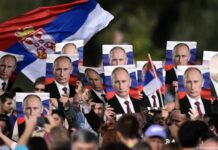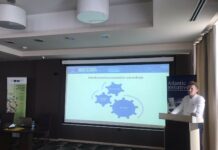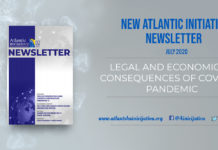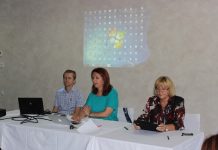Predrag Petrović
When Russia invaded Ukraine on February 24, 2022 it was wholeheartedly welcomed by Serbian extreme right-wingers, who celebrated it on social networks but also on the streets of cities in Serbia, Bosnia and Herzegovina, and Montenegro. The first rally in support of Russia was held in Belgrade on March 4 and, to the surprise of those unfamiliar with current trends in the Western Balkans, gathered several thousand people. Messages that could be heard at the rally included: “Serbs and Russians are brothers forever”, “Crimea is Russia, Kosovo is Serbia” and “Serbia, Russia we do not need [the European] Union”. Ratko Mladić, the wartime leader of the Bosnian Serbs convicted of genocide against Bosniaks in Srebrenica, also got a favorable mention. The crowd declared that “Serbia sits on only one – a Russian chair”. International observers, and some domestic ones, wondered which organizations and individuals had gathered so many people – and why they wholeheartedly support aggression against Ukraine when they themselves decry what they claim as the same thing happening to Serbia and Serbs during the 1990s?
Xenophobes, fascists and Chetniks together in support of Putin’s Russia
The main initiator of the pro-Russia rallies in Serbia was the relatively new ‘People’s Patrol’ organization led by Damnjan Knežević. Also present were Mladen Obradović, the leader of ‘Obraz’ (whose activities were banned by the Constitutional Court in 2012) as well as Mlađan Đorđević, leader of the pro-Russian ‘Liberation Movement’ party and a presidential candidate in Serbia’s elections this April. Rallies in Bosnia and Herzegovina and Montenegro were organized by ‘Serbian-Russian Bridge’ and ‘Night Wolves’, and members of the ‘Ravna Gora Chetnik Movement’ also took part. Numerous other smaller extreme right-wing groups (such as ‘Serbian Tricolor’) also invited citizens to attend on their social networks; invitations were also sent via extreme right-wing internet portals e.g. srbin.info, in4s.net.
What is the People’s Patrol?
‘People’s Patrol’ is an extreme right-wing organization founded in 2020 by Damnjan Knezevic. The focus of this organization is on anti-migrant activity, and its members act like parapolice: stopping migrants in the street, restricting their freedom of movement and carrying out civilian arrests. They record and disseminate all these activities via their social networks and other communication apps, spreading fear, xenophobia and Islamophobia in the process. In fact, harassing migrants is instrumental for this organization: these activities enable them to attract the attention of a wider audience and present themselves as a ‘savior of the nation’ from the enemy ‘other’. The People’s Patrol was established by the same people who previously founded ‘No Surrender of Kosovo and Metohija’, but when the focus shifted to anti-migrant activities a new name was chosen.[1] That anti-migrant activities are perhaps as instrumental as they are ideological for ‘People’s Patrol’ is also indicated by the fact with the start of the current conflict, they have quickly reoriented themselves to providing support to Russia – and over the last month there has been almost no anti-migrant content on their online profiles.[2]
It likewise attracted public attention when Denis Gariyev, leader of the ‘Russian Imperial Movement’, published a video message calling on Serbians to support “the renewal of Russia within its historical borders”.[3] The movement is known for its paramilitary ‘Imperial Legion’ wing, which has conducted trainings in urban warfare for extreme right-wingers in Russia and throughout Europe, and some of whose members have been convicted of terrorism. The US administration marked the movement as a global terrorist threat in mid-2020.[4] Andrei Rodionov, a Crimean politician and leader of the international ‘RUSOV-Russian-Slavic Unification and Revival’ movement, has also made pronouncements similar to those of Gariyev.
Return to the past: the ideological link between the Serbian extreme right and Putin’s Russia
Although there are certainly many differences among these extreme right-wing organizations[5], the common denominator for most of them is Saint Sava nationalism.[6] This ideology was created in the 1930s and its founder is seen to be Nikolaj Velimirović, bishop of the Serbian Orthodox Church. Its essence is in the combination of Serbian nationalism and Orthodox clericalism: in the “sacralization of the nation” and the “nationalization of religion”, with the Serbian nation rising to the status of a saint, while Orthodoxy becomes a national instead of universal religion.[7] From this comes the Serbian nationalist expression that “Serbs are a heavenly people”.
Saint Sava nationalism advocates for a return to traditional (medieval) values such as piety, chivalry and catholicity, and for the establishment of an Orthodox monarchy within historical Serbian borders. ‘Orthodox autocracy’ is the indirect rule of God in politics through a Monarch who is delegated by God, thus achieving a “symphony of state and church.” The king is an autocrat; that is, he is an inviolable and unlimited ruler, and political parties, the constitution and parliament do not only represent the complete opposite of this form of government, they are the monarch’s mortal enemies. As such supporters of this ideology resolutely reject Western culture, globalization, democracy, liberalism, human rights, republican values, anti-fascist tradition, and also ecumenism.[8]
If we now look at the ideology of Alexander Dugin,[9] the Russian philosopher and geopolitician who is considered a great influence on Putin[10], we will see why the extreme right in Serbia wholeheartedly supports the invasion of Ukraine. According to Dugin the “global elite”, which often tries to impose the values of liberal democracy (based on the individual and his/her inviolable human rights) on everyone, is responsible for the wars in the world. Liberals neglect the fact that the basic postulate of democracy is the right of people to choose, including the right to accept or reject democracy. That is why liberal-democracy is a totalitarian ideology – like its subspecies fascism and communism – and all three are products of the modern West. Dugin proposes the Fourth Political Theory, by which he seeks to restore the pre-modern values that existed in the great Eastern and Western civilizations of the past. According to Dugin the Middle Ages was the last period to uphold human dignity, tradition, values, chivalry and religion.[11] Eurasia, and especially Russia, is precisely the area where East and West meet: thus it represents a new value that should suppress the liberal West and provide a counterbalance to it in an increasingly multipolar world.
Serbia holds a special place for Dugin because, as a small country, it has opposed the “global elite” for a long time and in the Balkans is a bulwark of the Eurasian pole. A complete turn by Serbia to the West would mean the end of it because it could not regain Kosovo, but nor would it preserve its territorial integrity within the existing borders. That would be possible only in the multipolar world that Dugin advocates for, and which Putin is trying to achieve in practice. Dugin believes that Russia will not leave the Balkans to the West, nor will it abandon other Russian friends in the Balkans (in Bosnia, Montenegro and Macedonia), especially since the West is close to collapse. In his opinion Serbia should take responsibility for the Balkans – for the entire South Slavic (and partly Albanian) region! But that presumes two fundamental conditions: preserving neutrality and strengthening Serbia’s defense capabilities.[12]
“Next year in PriZren” – ‘Z’ as a symbol of extremist hopes for a return to Russia and Serbia’s historical borders

Within the first few days of Russia’s invasion of Ukraine, the marking in white of the Latin letters ‘Z’ and ‘V’ on Russian tanks, combat vehicles and trucks had attracted public attention.[13] There was much speculation on social media as to what the letters signified, and why Latin letters were on display when the Russian army only uses Cyrillic. Initial explanations from military experts ranged from these symbols indicating the origin of Russian forces (i.e. their direction and the direction of action), to being a signal for quick recognition among their own troops in order to avoid friendly fire.[14] The Russian Ministry of Defense did not engage in interpretations of these signs, but unofficially shared several illustrations on its Instagram profile through which it ingeniously inscribed propaganda messages into the letters ‘Z’ and ‘V’ – with Z meaning “For victory” (“За победу“) and V “Strength in truth” (“Сила V правде”)[15].
It didn’t take long for the ‘Z’ to be displayed by extreme right-wingers in Serbia who, in addition to the usual Russian propaganda messages, added a domestic meaning to the letter as embodied in the phrase “Next (or This) year in PriZren”. This slogan is widespread among extreme right-wingers and symbolizes the return of the Serbian Army to Kosovo and Serbia’s return to true sovereignty. But it also marks the beginning of the unification of “historical Serbian countries” because by then the Serbian Army will be superior and Serbia will have powerful foreign policy allies. By emphasizing the letter Z in the slogan, extreme right-wingers in Serbia are trying to suggest that Russia will help the “fraternal Serbian people in liberating territories that historically belong to Serbia”, just as Putin is doing in Ukraine today for the sake of Russia.
Numerous comments and messages on extreme right-wing channels and profiles declare that the Russian army will not stop at the western borders of Ukraine, but will continue further to the west and the Balkans. On social media you can even see maps that show, for example, how it is the same distance in kilometers from Luhansk to Odessa by air as from Belgrade to Odessa (interpreted by extremists as demonstrating that Russia is not so far from Serbia). The letter ‘Z’ has become a symbol of hope for these Serbian extreme right-wingers for the liberation of “historical Serbian territories” with the help of fraternal Russia.
Consequences: spreading fear and uncertainty in Serbia and the region
Although the first rally in support of Russia gathered several thousands of people in Belgrade, those that followed did not become widespread. However this does not mean it should be concluded that extreme right activity is only a marginal problem in the region. A recent BCSP survey found that the anti-migrant far right, whose only active representative today is the People’s Patrol, has had limited success in attracting new members – but has been very successful in normalizing attitudes and values incompatible with the democratic order. Not only do many citizens today have anti-migrant attitudes, but their number has been growing rapidly in the last year. Other research studies indicate that as many as one in four respondents supports the actions of an extreme right-wing organization.[16] The extreme right achieves this influence through activity online where, with very few resources and good networking, it can reach a large number of people, many of whom are not on the (extreme) right. It is the extreme right-wingers in Serbia who provide the most constant and intensive support for the Russian invasion on social media.
The inadequate reaction of the Serbian authorities only contributes to this normalization of attitudes, values and activities associated with the extreme right. For example, members of ‘People’s Patrol’ have been detained several times and misdemeanor charges filed against them but without any consequence, and they continue to operate unhindered – only now sporting a halo as “victims of the regime”. No less important is the fact that the government does not unequivocally and publicly condemn extreme right-wing activities. Plus the fact that the private media, which wholeheartedly supports the policy of the authorities in Belgrade, have been spreading Russian propaganda for years. The most drastic example is the tabloid Informer and its scandalous front page headline suggesting that it was Ukraine who attacked Russia.[17]
In the absence of a response from state institutions we have citizens and activists concerned about security and the future who are reacting in their own way. For example, the lawyers Aleksandar Olinek and Cedomir Stojkovic have filed separate criminal charges against the organizers of the pro-Russia rallies on the grounds that they “called and encouraged the citizens gathered to an aggressive war”, which is a crime punishable by 2 to 12 years in prison.[18]
Under such conditions, citizens in Serbia and the (politically unstable and economically devastated) region are rightly afraid that the concept of the “Serbian world” – which the Serbian authorities advocating it say represents the unification of Serbs through common language, customs, science and sports rather than common territories – is in fact a “made-up” i.e. cosmetically acceptable version of the vision advocated by Serbian extreme right-wingers,[19] which seems to be becoming increasingly true under the current geopolitical circumstances.
[1] Read more: Petrović, Predrag, and Marija Ignjatijević. Migrants Are Leaving, but Hatred Remains: The Anti-Migrant Extreme Right in Serbia (Belgrade: Belgrade Centre for Security Policy, 2022).
[2] FB page of ‘Narodna patrola’: https://www.facebook.com/narodnapatrola.
[3] FOR RUSSIA: U petak veliki protest u Beogradu, stigla podrška od ruske braće! Srbin.info, 1. mart 2022, https://srbin.info/politika/za-rusiju-u-petak-veliki-protest-u-beogradu-stigla-podrska-od-ruske-brace-video/?lang=lat.
[4] More about the Russian Imperial Movement: Jason Blazakis and Colin Clarke, Inside the Russian Imperial Movement. (New York: The Soufan Center, 2020). https://thesoufancenter.org/wp-content/uploads/2020/06/TSC-Report-Inside-the-Russian-Imperial-Movement-Practical-Implications-of-U.S.-Sanctions.pdf.
[5] In terms of the war in Ukraine, the biggest difference is between Serbian neo-Nazi and nationalist right-wing groups, as the former do not provide unequivocal support for the Russian invasion. For example, on the website of the online store ‘Serbon Shop’, which sells clothes with neo-Nazi symbols, you can see an illustration with the Ukrainian and Russian flags, in front of which two hands are firmly held, and over the whole illustration a message “Enough of fraternal wars!” On the hands are drawn neo-Nazi symbols. https://www.facebook.com/serbonshop/photos/a.151844412197165/929141631134102/.
[6] Saint Sava lived at the turn of the 13th century. There are no elements in his works to support what emerges seven centuries later as an ideology bearing his name. Saint Sava is known for renouncing the throne in the name of monastic life, and for providing autocephaly to the Serbian Orthodox Church. He is also celebrated in Serbia as an educator. According to historian Milivoje Beslin, Saint Sava was both modern and pragmatic, and political during his time. “He understood the time, understood the international context, acted even revolutionary, destroying established principles and church canons themselves”. Bešlin, Milivoj, ‘Saint Sava ideology without Saint Sava’, Accusative, February 21, 2021. https://www.akuzativ.com/teme/921-svetosavlje-bez-svetog-save.
[7] Falina, Maria, ‘Saint Sava ideology. A Case Study in the Nationalization of Religion’, Schweitzerische Zeitschrift für Religions-und Kulturgeschichte 101 (2007): 505-27, 526.
[8] See, for example, the program of the ‘Monarchist Club Carostavnik’ : https://carostavnik.blogspot.com/p/blog-page_21.html.
[9] Alexander Dugin’s main works are ‘Foundations of Geopolitics: The Geopolitical Future of Russia’ and ‘The Fourth Political Theory’.
[10] Steinmann, Luca. ‘The Illiberal Far-Right of Aleksandar Dugin’, Reset dialogues, 4 December 2018,
https://www.resetdoc.org/story/illiberal-far-right-aleksandr-dugin-conversation/.
[11] Alexander Gelyevich Dugin: “I think we live essentially at the end of time”, RTS, 22 June 2022,
[12] See more about this in the interview that Dugin gave in the magazine of the Ministry of Defense of Serbia: Glisic, Dusan. ‘Serbia has a responsibility for the Balkans’, Defense, no. 332 (February 2020), http://www.odbrana.mod.gov.rs/grab_file.php?id_clanka=9016&redni_broj=332&putanja=Odbrana332-str48-53.pdf&id_casopisa=1.
[13] It was noticed that these letters in some units are framed by a triangle, square or circle, as well as that the letters “X”, “O” and “A” are also used.
[14] Aleksandar Radić, a military analyst, claims that it is not really about letters, but “scribbles” written in a hurry in order to recognize the troops. Nova S. “How did the letter Z become a Russian symbol of war?” March 11, 2022, https://www.youtube.com/watch?v=EJSjGSPlD_4.
[15] Later other propaganda slogans were added – “The task will be completed” (Задача будет выполнена), “Denazification” (дeнаZификация), “Demilitarization” (демилитариZация), “Let’s not forget” (Не Zабудем) itd. Instagram account of Ministry of Defense of Russia: https://www.instagram.com/mil_ru/.
[16] Petrović, Predrag and Ignjatijević, Marija. Migrants are leaving, hatred remains: the anti-migrant extreme right in Serbia. Belgrade: Belgrade Center for Security Policy, 2022, 43-46
[17] Kisić, Izabela. “Pro-Russian propaganda in Serbia.” Atlantic Initiative, March 20, 2022 https://atlantskainicijativa.org/proruska-propaganda-u-srbiji/.
[18] Beta. ‘Olenik: “Criminal charges against right-wingers for calling for aggressive war”’, Danas, March 15, 2022, https://www.danas.rs/vesti/politika/olenik-krivicna-prijava-protiv-desnicara-zbog-pozivanja-na-agresivni-rat/.
[19] Vukićević, Jasna, and Gjeraqina Tuhina.‘Serbian World’ A Concept That Makes The Region Nervous’ Slobodna Evropa, March 15, 2022. https://www.slobodnaevropa.org/a/srpski-svet-srbija-balkan-/31521168.html.








